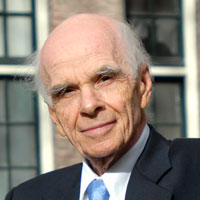*Capitalism is a complex, dynamic, adaptive and non-linear system because it has elements or agents in large numbers that interact with each other – forming one or more structures that originate from the interactions between such agents.
Complex systems are characterized by their dynamism, whose fundamental characteristics are their sensitive dependence on the initial conditions, whereby minimal differences at the beginning of any process can lead to completely different and/or opposite situations over time. The opinion of Ervin Laszlo, Ph.D. of the Sorbonne and president of the Budapest Club, presented in the book O Ponto do Caos (The Point of Chaos), is that a dynamic system, in society or in a computer simulation, is governed by attractors.

According to Lazlo, the attractors define “the phase portrait” of the system: how it behaves over time. Stable attractors pull the developmental trajectory of the system into a recurring and recognizable pattern, leading it to converge at a given point (if the system is governed by point attractors) or to describe cycles through different states (when it is under the command of periodic attractors).
An attractor is the set of points in the phase space for which a system tends to go as it evolves. The attractor can be, however, a single point, a closed curve (limit cycle) that describes a system of periodic behavior, or a fractal (also called a strange attractor), when the system presents chaos. However, dynamic systems can also achieve a state in which the attractors that emerge are not stable, but “strange”. They are the “chaotic attractors”.
In chaotic systems, the movement never repeats itself, although it often has to occur within certain limits. Thus, only an infinitely complex figure – a fractal – can account for representing this trajectory that is never repeated in phase space. Change and time are the two fundamental aspects of chaos.
As an example of stable attractors in the capitalist system, one can cite family consumption, business investment, and foreign trade (export, less import) that operate to promote economic growth, income, and employment.
The strange or chaotic attractors that lead to the destabilization of the capitalist system in each country need to be eliminated for it to evolve, otherwise it will be brought to collapse.
When household consumption, corporate investment, and foreign trade gains decline, there should be the government’s “feedback” and control mechanism to, through public spending and monetary, foreign exchange and fiscal policies to act to compensate for the decline cited, and thereby ensure the stability of the economic system. This was the model proposed by Lord Keynes who formulated the so-called Keynesian model of economic management.
Because it is a dynamic system, there may be strange or chaotic attractors that destabilize the system, even if there is feedback or control by the government. These strange attractors may be located in the economic sphere, such as high public debt, high balance of payments deficits, high public expenditure or high levels of inflation, in the political sphere, such as the instability of the country’s political system and, in the social sphere, mass unemployment or high levels of crime. Strange or chaotic attractors can lead to the destabilization of the capitalist system.
Chaos refers primarily to something that evolves over time.
Chaos Theory explains the functioning of complex and dynamic systems. It is Ervin Laszlo’s claim that systems go into a state of chaos when fluctuations that have until then, been corrected by “feedback” or self-stabilizing negative feedbacks are out of control.
The development trajectory becomes non-linear: prevailing trends collapse and in its place – several complex developments emerge. Rarely is chaos an extended condition. In most cases, it is only a transitional time between more stable states. When fluctuations in the system reach levels of irreversibility, the system reaches a critical point where it collapses or undergoes rapid evolution towards a state resistant to fluctuations that have destabilized it (revolutionary breakthrough).
If this path of revolutionary advancement is selected, the system evolves into a state in which it gains more flexibility, greater structural complexity, and additional levels of organization.
When it is subject to “fluctuations,” a dynamic system such as the economic system of a country is brought to a point of bifurcation from which the system reaches a new dynamic stability (revolutionary breakthrough) or will collapse. At the point of bifurcation, the system has to be restructured or will collapse.
This is the situation experienced by the economy of many countries of the world that, after the crisis that broke out in 2008 in the United States and spread throughout the planet, there was no restructuring of their economic systems. This restructuring would require the adoption of measures that would contribute to the elimination of the strange attractors that may be located as already mentioned in the economic sphere, such as the high public debt, the high balance of payments deficit, high public expenditure or the high level of inflation, in the political sphere, such as the instability of the country’s political system and, in the social sphere, such as, for example, mass unemployment and high levels of crime.
The strange or chaotic attractors that lead to the destabilization of the capitalist system in each country need to be eliminated for it to evolve, otherwise it will be brought to collapse.
•••••••••••••••••••••••••••••••••••••••••••••
Dr Fernando Alcoforado
is an engineer and professor, and author of 13 books addressing such issues as Economics, Climate Change, Energy, and Science & Technology.
Tweet @BLOGFALCOFORADO
•••••••••••••••••••••••••••••••••••••••••••••
*This article has been edited for brevity.*
The full article is available below
[mdocs cat=”Dr. Fernando Alcoforado Publications”]
Capitalism Capitalism Capitalism










